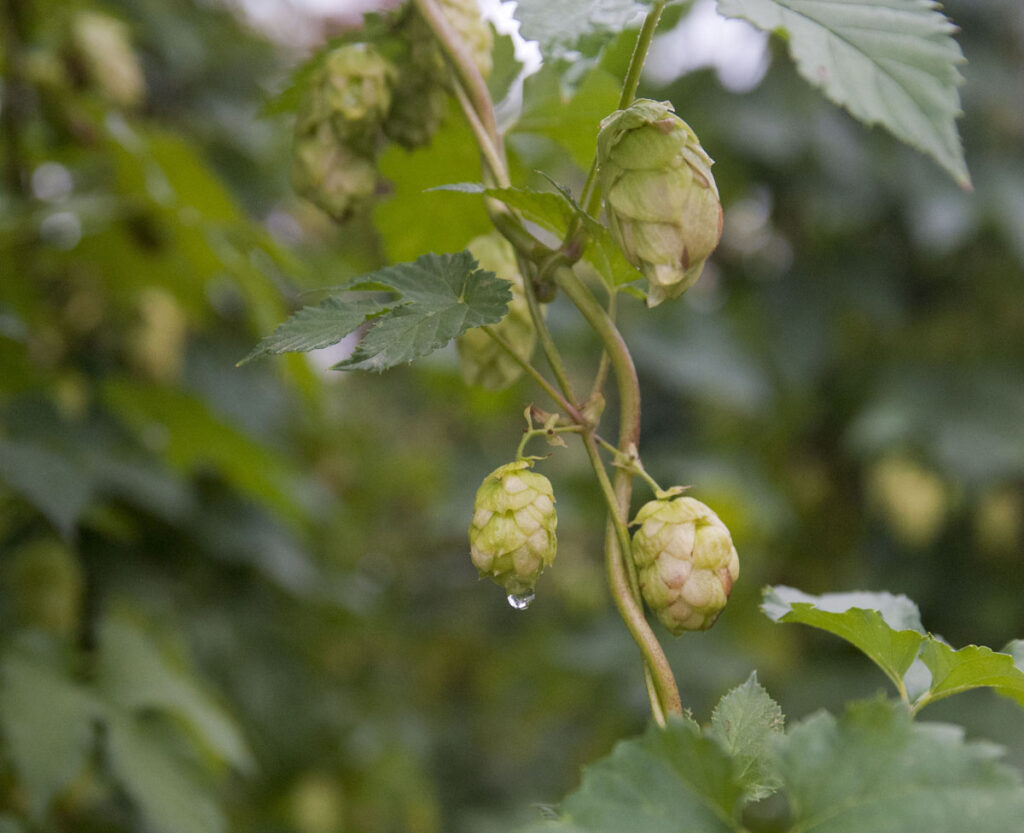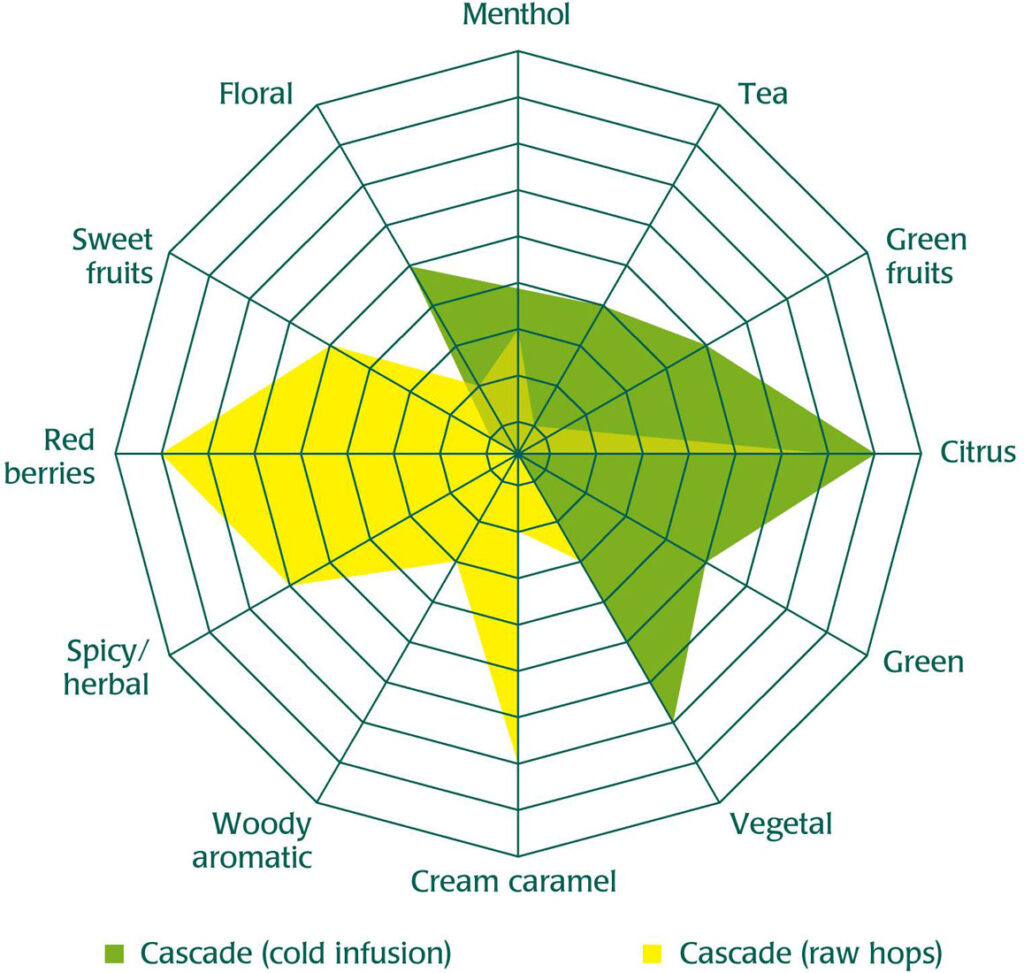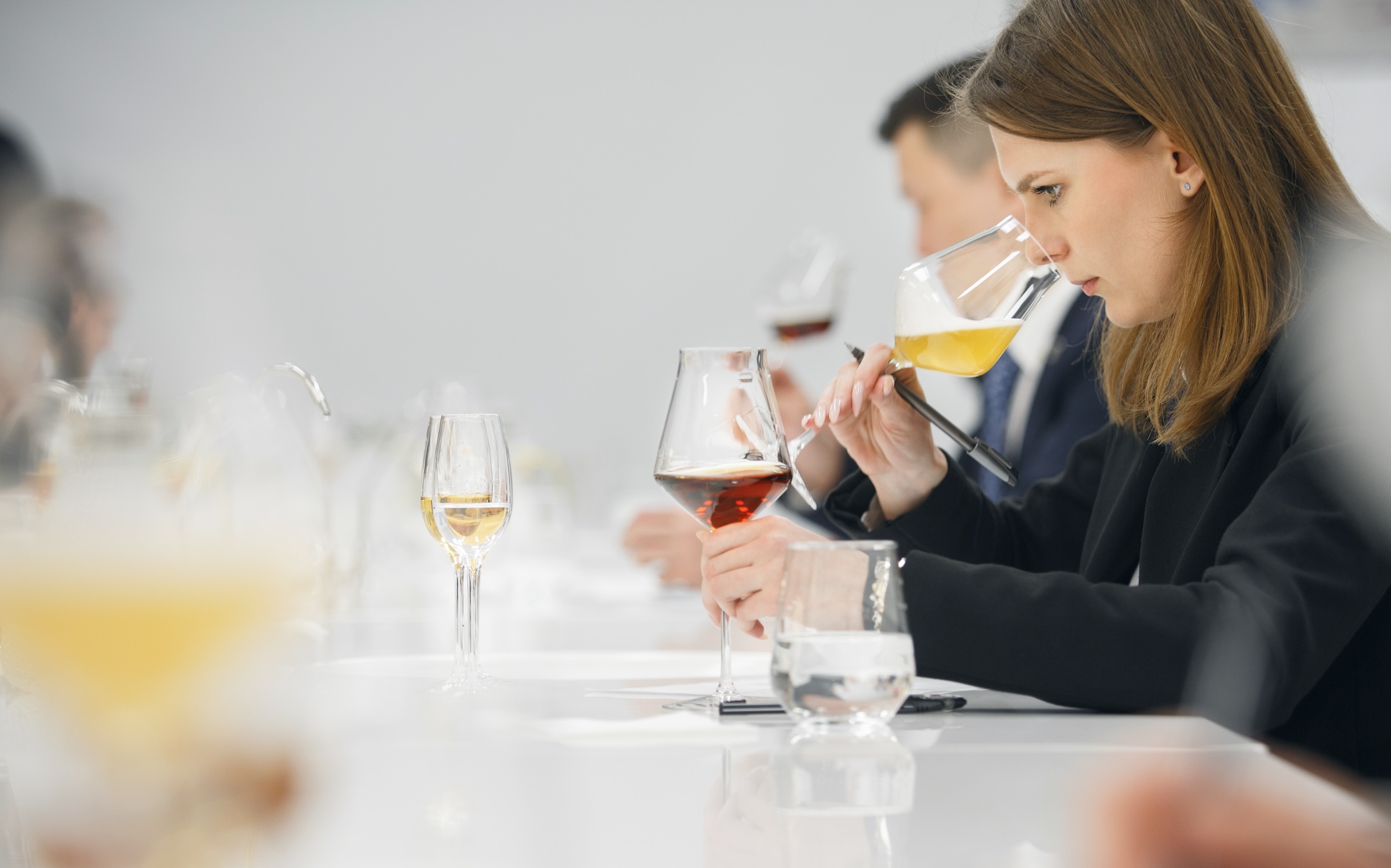© 2024, Randy Mosher / Craft Beer & Brewing Magazine
Humans have known hops for millennia, but despite this long association—romance, some would say—they remain an enduring mystery, especially when trying to make sense of the complex sensations they evoke.

Let’s start with the easy part: bitterness. This requires no special talent to perceive. We experience just a handful of tastes, each with its own mechanisms. Unlike aromas, they do not blend together to create novel sensations. With 26 unique types of receptors, bitterness is by far the most biologically complex taste, essential for responding to a wide range of suspicious chemical types. Regardless, the brain tosses responses from all 26 receptors into the same bucket, simply labeled “bitter.”
We all perceive bitterness somewhat differently. Because we have multiple bitter receptors and may have more than one copy of each, this opens the door to genetic variation, since some receptors come in more more- or less-sensitive versions. Most well known is the so-called “supertaster” phenomenon, but there are 93 other known genetic variations in at least ten bitter receptors in humans.
Although it often feels otherwise, perceptually, there is only one type of bitterness. However, bitter percepts may be altered by sensations from other senses, especially astringency from tannins and other polyphenols. This creates a multi-modal sensation as senses merge into a flavor “object” that we can recognize and recall. Almost as soon as they enter the brain, our chemical senses start blending together, and this multimodality is largely how we process our world. Rather than keeping tract of innumerable parts and pieces from multiple senses, it’s much more efficient to combine them and tag the entire thing with a single label
In beer, hop bitterness and aroma are processed together. Geraniol, the rose-smelling chemical found in classic West Coast hops, makes bitterness smoother, but the terpene hydrocarbons abundant in wet-hopped beers have the opposite effect. It works the other way around, too: hop bitter compounds can alter the duration and sensory profile of hop aroma compounds.
The Chemistry and Psychology of Hops
Hops produce a cornucopia of terpenes and related chemicals, making beer unique among alcoholic beverages. There’s a lot of them in hops. Jeff Daily, sensory manager for the hop company John I. Haas, says the number he generally quotes is 600–800 known to be present in various forms of hops. Terpenes proper are hydrocarbons; terpenoid is a broader term including alcohols and other variants. All share certain structural characteristics but may incorporate functional groups that change their aroma, stability, solubility and other characteristics. Beyond terpenoids, hops bring green-smelling aldehydes, fruity and rummy esters, spicy phenols and exotic thiols smelling of grapefruit, passionfruit or less pleasantly, cat pee.
You may have heard about terpenes in connection with marijuana, a plant closely related to hops and sharing many biological pathways with them. Terpenoids are abundant in citrus, flowers, parsley/carrot family members, herbs and spices such as nutmeg, cardamom and coriander. This variety makes their vocabulary quite complex and not always top of mind. To further muddy the water, despite the abundance of terpenoids, it’s not always obvious, even to experts, which of them are really responsible for a hop’s aroma. Of the hundreds of terpenoids, none of them has been identified as really, truly smelling like hops.
Hop odor changes dramatically from harvest through beer production. In the field, they contain a lot of the hydrocarbon terpenes, which tend to have sharp, bright aromas—think raw carrots and turpentine. Highly volatile, many are partially blown off during hop kilning. More are lost during the boil, so hops are usually added late in the boil or in the whirlpool to help preserve aromatics.
The hop chemicals you put into a beer may end up being something quite different in the glass. Terpenes are highly unstable, readily transforming into other chemicals with different characteristics. For this reason, most hop sellers use two profiles on their spider charts. In the example here, it’s striking how different the Cascade profile is between raw hops and a cold infusion. Brewing creates further differences, in ways that are not that easy to predict. This transformation is especially dramatic during fermentation.

A “spider”or “Radar” plot shows intensities of multiple aroma characteristics of Cascade hops in two versions. Source: Barth-Haas, “The Hop Aroma Compendium, Volume 1” (2011)
Hop aromas in beer are what are known as configural smells. For the same reasons our brains combine sensations to create multisensory “objects,” it also does this with aromas. Each smell enters the body as a stream of inhaled chemicals, generating a complex pattern of olfactory responses from among our approximately 400 receptor types. This pattern is enhanced and adjusted as it flows from the receptors through the olfactory bulb. At the output of the olfactory bulb into the brain, something weird and wonderful happens: the response pattern generated by the chemistry is tossed out—lost forever—and replaced by a new one, of meaning, value, hedonics, context and more. This, like our brains’ multimodal strategy, economizes on memory and other resources by embodying our multifaceted responses to aroma chemicals into a single percept. However, this also makes these aroma objects challenging to deconstruct. For me, hops are just about the most impenetrable of all smells.
Something else is also going on: olfactory “buffers.” Well-demonstrated in wine, this happens when a group of similar chemicals—esters in the wine case—near their detection thresholds stimulate related olfactory receptors in an overlapping way. This results in a combined aroma note that remains unchanged even when most of its components are removed. In the wine study, all but one of its fourteen fruity esters were replaced, with no noticeable change. Something similar happens with hop terpenoids. Cooperative effects have been observed between geraniol (rose/geranium), linalool (lavender/coriander/orange) and beta-citronellol (lemongrass).
This is just one example of several possible olfactory interactions. These may be cooperative like the esters, or destructive, with one chemical squashing perception of another but displaying little of its own smell. Burnt, barnyard, tar and musty smells can to this. Although rare, there are true synergies, in which a small, even undetectable amount of one chemical can boost or alter the intensity of another, and these can be important in fruitiness. Sulfur-containing thiols are notorious potentiators.
Also rare are creative interactions, where two or more aroma compounds come together to create a new aroma unlike any of its components. It is believed that “melon” flavor in hops is one example, and when you add 3SMP (3-sulfanyl-4-methylpentan-1-ol), a thiol with a sulfurous/onion odor to the three terpenoids mentioned above, you get a lime-like citrus odor.
What we think of as a generally “hoppy” aroma is itself configural smell not really resembling any of its components. These configural smells are often folded into more complex mixtures. Beer itself is a configural smell made up of a lot of others: hops, malts, and fermentation. The next time you pop a cap off a beer bottle, give it a sniff. That is beer’s configural odor.
In Your Face: Smelling hops
All of this paints a picture of horrendous complexity, and it’s a daunting challenge to smell hops in a meaningful way and also navigate how to incorporate them into our beers. Fortunately, we have a pretty good ability to smell, and with some practice, we can develop a workable vocabulary that helps us wrap our heads around this herb. Spider diagrams like the one above can act as a helpful checklist of things to smell for, and you can even make up a blank one and connect the dots to make your own profile or create your own unique spider, reflecting how you perceive the various facets of hops.
We humans are really good at categorizing just about anything, and hops are an excellent candidate. One way to organize varieties is more-or-less along lines of national origin. For a homebrewing book, I once made index cards of several dozen types and laid them all out on the dining table, grouped by their similarities. It was a worthwhile exercise, and I ended up with seven categories representing concepts such as “noble” or “Brittanic,” with each incorporating hops that fit the description regardless of where they actually originated. Within each group, I ranked them in order of some relevant attribute, which made it really easy to find substitutes and try novel varieties.
The long-established method of evaluating hops is called “rubbing.” It involves putting a whole cone or broken-up pellet on the heel of your hand and rubbing until it smears across your skin and heats up a bit. Then cup your hands and smell. It helps to settle yourself in a mind-space with no expectations and just let any random thought pop into your head. Make a note and go back for more. It’s messy, so have some isopropyl alcohol handy to clean up.
Combining hop varieties is really where the magic is in hop-forward IPAs. There’s a clever hack for this: use a cannabis grinder. Once you’ve used it to turn hop pellets to dust, it’s easy to make and evaluate blends by simply mixing specific amounts of different varieties until the mixture is pleasing. You can even sprinkle the mixed dust over a neutral beer and smell. It’s not a perfect prototype, but it’s a fine start.
With their immense complexity and somewhat alien nature, hops can be really intimidating. The good news is that you don’t have to understand it all to make or enjoy really delicious beers. But if you want to really dig into it and try to understand everything, that journey is just about endless, and for a guy like me, that means the fun will never end.
Further Reading:
Vicente Ferreira, “A New Classification of Perceptual Interactions between Odorants to Interpret Complex Aroma Systems. Application to Model Wine Aroma. (2021)
Christina Dietz, :”The Multisensory perception of hop oil: a review.” (2022)

